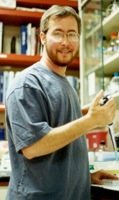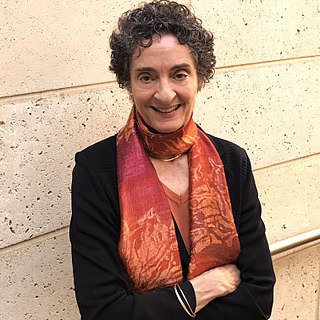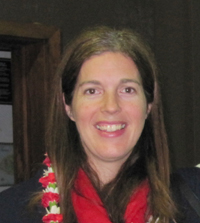Related Research Articles

Neuropil is any area in the nervous system composed of mostly unmyelinated axons, dendrites and glial cell processes that forms a synaptically dense region containing a relatively low number of cell bodies. The most prevalent anatomical region of neuropil is the brain which, although not completely composed of neuropil, does have the largest and highest synaptically concentrated areas of neuropil in the body. For example, the neocortex and olfactory bulb both contain neuropil.

The mushroom bodies or corpora pedunculata are a pair of structures in the brain of arthropods, including insects and crustaceans, and some annelids. They are known to play a role in olfactory learning and memory. In most insects, the mushroom bodies and the lateral horn are the two higher brain regions that receive olfactory information from the antennal lobe via projection neurons. They were first identified and described by French biologist Félix Dujardin in 1850.
Synaptogenesis is the formation of synapses between neurons in the nervous system. Although it occurs throughout a healthy person's lifespan, an explosion of synapse formation occurs during early brain development, known as exuberant synaptogenesis. Synaptogenesis is particularly important during an individual's critical period, during which there is a certain degree of synaptic pruning due to competition for neural growth factors by neurons and synapses. Processes that are not used, or inhibited during their critical period will fail to develop normally later on in life.

Retrograde signaling in biology is the process where a signal travels backwards from a target source to its original source. For example, the nucleus of a cell is the original source for creating signaling proteins. During retrograde signaling, instead of signals leaving the nucleus, they are sent to the nucleus. In cell biology, this type of signaling typically occurs between the mitochondria or chloroplast and the nucleus. Signaling molecules from the mitochondria or chloroplast act on the nucleus to affect nuclear gene expression. In this regard, the chloroplast or mitochondria act as a sensor for internal external stimuli which activate a signaling pathway.
Martin Heisenberg is a German neurobiologist and geneticist. Before his retirement in 2008, he held the professorial chair for genetics and neurobiology at the Bio Centre of the University of Würzburg. Since then, he continues his research with a senior professorship at the Rudolf Virchow Center of the University of Würzburg. Heisenberg studied chemistry and molecular biology in Munich, Tübingen and Pasadena. In 1975 he became Professor of genetics and neurobiology at the University of Würzburg. Heisenberg's work has focused on the neurogenetics of Drosophila, with the aim of investigating the genetic foundations of the Drosophila brain by studying the effect of genetic mutations on brain function. In addition, Heisenberg contributed a number of essays on the topics of science in society, perception, as well as the question of the freedom of the will. He was elected as a member of the Leopoldina in 1989.

Benjamin "Ben" A. Barres was an American neurobiologist at Stanford University. His research focused on the interaction between neurons and glial cells in the nervous system. Beginning in 2008, he was chair of the Neurobiology Department at Stanford University School of Medicine. He transitioned to male in 1997, and became the first openly transgender scientist in the National Academy of Sciences in 2013. Barres is also known for his pioneering activism for equal opportunity in science, often citing his experiences as both a male and female scientist.

Carla J. Shatz is an American neurobiologist and an elected member of the American Academy of Arts and Sciences, the American Philosophical Society, the National Academy of Sciences, and the National Academy of Medicine.

Alexander "Axel" Borst is a German neurobiologist. He is director at the Max Planck Institute for Biological Intelligence and head of the department Circuits – Computation – Models.
Lawrence C. Katz was an American neurobiologist. He was an investigator at the Howard Hughes Medical Institute. His lab was located in Duke University Medical Center, where he was the James B. Duke Professor of Neurobiology.

Leslie Birgit Vosshall is an American neurobiologist and currently a Howard Hughes Medical Institute (HHMI) investigator and the Robin Chemers Neustein Professor of Neurogenetics and Behavior at The Rockefeller University. In 2022 she was appointed Chief Scientific Officer and vice president of HHMI. She is also the director of the Kavli Neural Systems Institute at The Rockefeller University. Vosshall, a member of the National Academy of Sciences, is known for her contributions to the field of olfaction, particularly for the discovery and subsequent characterization of the insect olfactory receptor family, and the genetic basis of chemosensory behavior in mosquitoes. She has also extended her research into the study of human olfaction, revealing parts of human genetic olfactory architecture, and finding variations in odorant receptors that determine individuals’ abilities to detect odors.
Lu Chen is a Chinese-born American neuroscientist, who is a Professor of Neurosurgery, and of Psychiatry and Behavioral Sciences at Stanford University, and is a member of the Stanford Neurosciences Institute. She was previously an Associate Professor of Neurobiology and a member of the Helen Wills Neuroscience Institute at the University of California, Berkeley.
A Drosophila connectome is a list of neurons in the Drosophila melanogaster nervous system, and the chemical synapses between them. The fly's nervous system consists of the brain plus the ventral nerve cord, and both are known to differ considerably between male and female. Dense connectomes have been completed for the female adult brain, the male nerve cord, and the female larval stage. The available connectomes show only chemical synapses - other forms of inter-neuron communication such as gap junctions or neuromodulators are not represented. Drosophila is the most complex creature with a connectome, which had only been previously obtained for three other simpler organisms, first C. elegans. The connectomes have been obtained by the methods of neural circuit reconstruction, which over the course of many years worked up through various subsets of the fly brain to the almost full connectomes that exist today.
Beth Stevens is an associate professor in the Department of Neurology at Harvard Medical School and the F. M. Kirby Neurobiology Center at Boston Children’s Hospital. She has helped to identify the role of microglia and complement proteins in the "pruning" or removal of synaptic cells during brain development, and has also determined that the impaired or abnormal microglial function could be responsible for diseases like autism, schizophrenia, and Alzheimer's.

The Department of Neurobiology at Harvard Medical School is located in the Longwood Medical Area of Boston, MA. The Department is part of the Basic Research Program at Harvard Medical School, with research pertaining to development of the nervous system, sensory neuroscience, neurophysiology, and behavior. The Department was founded by Stephen W. Kuffler in 1966, the first department dedicated to Neurobiology in the world. The mission of the Department is “to understand the workings of the brain through basic research and to use that knowledge to work toward preventive and therapeutic methods that alleviate neurological diseases”.

Barry J. Dickson is an Australian neurobiologist who studies the development of neuronal networks in the fruit fly Drosophila melanogaster. Dickson is a group leader at the Janelia Research Campus of the Howard Hughes Medical Institute in Loudoun County, Virginia and a former scientific director of the Research Institute of Molecular Pathology (IMP) in Vienna, Austria.
Target selection is the process by which axons selectively target other cells for synapse formation. Synapses are structures which enable electrical or chemical signals to pass between nerves. While the mechanisms governing target specificity remain incompletely understood, it has been shown in many organisms that a combination of genetic and activity-based mechanisms govern initial target selection and refinement. The process of target selection has multiple steps that include axon pathfinding when neurons extend processes to specific regions, cellular target selection when neurons choose appropriate partners in a target region from a multitude of potential partners, and subcellular target selection where axons often target particular regions of a partner neuron.
Nilay Yapici is a Turkish neuroscientist at Cornell University in Ithaca, New York, where she is the Nancy and Peter Meinig Family Investigator in the Life Sciences and Adelson Sesquicentennial Fellow in the Department of Neurobiology and Behavior. Yapici studies the neural circuits underlying decision making and feeding behavior in fruit fly models.
Yishi Jin is a Chinese-American neurobiologist who is a professor at the Howard Hughes Medical Institute. She is interested in neural development and regeneration in nematode Caenorhabditis elegans. Jin is a Fellow of the American Association for the Advancement of Science, American Academy of Arts and Sciences and American Society for Cell Biology.
Chinfei Chen is an American neuroscientist and member of the American Academy of Arts and Sciences studying synaptic plasticity. She is a professor of neurology and neurobiology at Harvard Medical School and the Associate Director of the Harvard Program in Neuroscience. She also works as a research associate in neurology at the Boston Children's Hospital.
References
- ↑ "2008 MacArthur Fellows:Rachel Wilson". MacArthur Foundation. 2008. Archived from the original on 2008-09-27. Retrieved 2008-09-25.
- 1 2 3 "Rachel Wilson: Death Defying". The Scientist Magazine®. Retrieved 2020-03-28.
- ↑ Wilson, Rachel I.; Nicoll, Roger A. (2001-03-29). "Endogenous cannabinoids mediate retrograde signalling at hippocampal synapses". Nature. 410 (6828): 588–592. Bibcode:2001Natur.410..588W. doi:10.1038/35069076. ISSN 1476-4687. PMID 11279497. S2CID 52803281.
- ↑ Carroll, Linda (2002-01-29). "Marijuana's Effects: More Than Munchies". The New York Times. ISSN 0362-4331 . Retrieved 2020-03-28.
- ↑ "Young Neurobiologist Honored For Research Into The Fruit-Fly's 'Smell' Circuit". Medical News Today. 2007-10-26.
- ↑ "Mapping the fruit-fly's 'smell' circuit wins Eppendorf/Science Prize:Young neurobiologists honored for research". American Association for the Advancement of Science. 2007-10-25.
- ↑ Carolyn Y. Johnson (2008-09-23). "Local scientists honored, boosted by 'genius' grants: MacArthur fellowships stun winners". Boston Globe.
- ↑ "2014 National Laureates - Blavatnik Awards for Young Scientists". blavatnikawards.org.
- ↑ "Blavatnik Awards for Young Scientists". www.nyas.org.
- ↑ "Rachel Wilson". www.nasonline.org. Retrieved 2019-09-09.